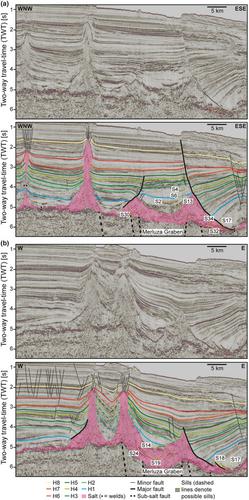当前位置:
X-MOL 学术
›
Basin Res.
›
论文详情
Our official English website, www.x-mol.net, welcomes your
feedback! (Note: you will need to create a separate account there.)
Salt–magma interactions influence intrusion distribution and salt tectonics in the Santos Basin, offshore Brazil
Basin Research ( IF 2.8 ) Pub Date : 2021-01-07 , DOI: 10.1111/bre.12537 Craig Magee 1 , Leonardo Muniz‐Pichel 2 , Amber L. Madden‐Nadeau 3 , Christopher A‐L. Jackson 2 , Webster Mohriak 4
Basin Research ( IF 2.8 ) Pub Date : 2021-01-07 , DOI: 10.1111/bre.12537 Craig Magee 1 , Leonardo Muniz‐Pichel 2 , Amber L. Madden‐Nadeau 3 , Christopher A‐L. Jackson 2 , Webster Mohriak 4
Affiliation

|
Many sedimentary basins host thick evaporite (salt) deposits. Some of these basins also host extensive igneous intrusion networks. It thus seems inevitable that, in some locations, magma will interact with salt. Yet how interaction between these materials may influence salt tectonics or magma emplacement, particularly at the basin-scale, remains poorly understood. We use 3D seismic reflection data from the Santos Basin, offshore Brazil to image 38 igneous intrusions spatially related to thick Aptian salt. Based on identified seismic–stratigraphic relationships, we suggest sill emplacement likely occurred during the late Albian-to-Santonian. We show intra-salt sills are geometrically similar to but laterally offset from supra-salt sills. We suggest ascending magma was arrested by the salt in some areas, but not others, perhaps due to differences in evaporite lithology. Our mapping also reveals most sills occur within and above the presalt Merluza Graben, an area characterized by Albian-to-Neogene, salt-detached extension. In adjacent areas, where there are few intrusions, salt deformation was driven by post-Santonian diapir rise. We suggest emplacement of hot magma within evaporites above the Merluza Graben enhanced Albian-to-Santonian salt movement, but that crystallization of the intrusion network restricted post-Santonian diapirism. Our work indicates salt–magma interaction can influence salt tectonics, as well as the distribution of magma plumbing systems, and thus could impact basin evolution.
中文翻译:

盐岩浆相互作用影响巴西近海桑托斯盆地的侵入分布和盐构造
许多沉积盆地都蕴藏着浓厚的蒸发岩(盐)沉积物。其中一些盆地还拥有广泛的火成岩侵入网络。因此,在某些地方,岩浆将不可避免地与盐相互作用。然而,这些物质之间的相互作用如何影响盐构造或岩浆的沉积,特别是在盆地规模上,仍然知之甚少。我们使用来自巴西近海桑托斯盆地的3D地震反射数据,对38个与浓稠的Aptian盐在空间上相关的火成岩侵入进行成像。根据已确定的地震地层关系,我们建议在阿尔比亚至桑顿时期晚期可能发生基岩侵位。我们显示了盐内基石在几何上与上盐基石相似,但在横向上偏离了盐基基石。我们建议上升岩浆在某些区域被盐阻止,但在其他区域则没有,可能是由于蒸发岩岩性的差异。我们的地图还显示,大多数基岩都发生在盐下Merluza Graben内和之上,该区域以Albian-to-Neogene,盐分延伸为特征。在附近很少有侵入的地区,盐的变形是由桑托尼亚后的底辟上升引起的。我们建议在Merluza Graben上方的蒸发岩中放置热岩浆可增强Albian到Santonian盐的运动,但是侵入网络的结晶限制了Santonian后的二叠纪。我们的工作表明,盐与岩浆的相互作用会影响盐构造,以及岩浆管道系统的分布,从而可能影响盆地的演化。盐分离扩展。在附近很少有侵入的地区,盐的变形是由桑托尼亚后的底辟上升引起的。我们建议在Merluza Graben上方的蒸发岩中放置热岩浆可增强Albian到Santonian盐的运动,但是侵入网络的结晶限制了Santonian后的二叠纪。我们的工作表明,盐与岩浆的相互作用会影响盐构造,以及岩浆管道系统的分布,从而可能影响盆地的演化。盐分离扩展。在附近很少有侵入的地区,盐的变形是由桑托尼亚后的底辟上升引起的。我们建议在Merluza Graben上方的蒸发岩中放置热岩浆可增强Albian到Santonian盐的运动,但是侵入网络的结晶限制了Santonian后的二叠纪。我们的工作表明,盐与岩浆的相互作用会影响盐构造,以及岩浆管道系统的分布,从而可能影响盆地的演化。
更新日期:2021-01-07
中文翻译:

盐岩浆相互作用影响巴西近海桑托斯盆地的侵入分布和盐构造
许多沉积盆地都蕴藏着浓厚的蒸发岩(盐)沉积物。其中一些盆地还拥有广泛的火成岩侵入网络。因此,在某些地方,岩浆将不可避免地与盐相互作用。然而,这些物质之间的相互作用如何影响盐构造或岩浆的沉积,特别是在盆地规模上,仍然知之甚少。我们使用来自巴西近海桑托斯盆地的3D地震反射数据,对38个与浓稠的Aptian盐在空间上相关的火成岩侵入进行成像。根据已确定的地震地层关系,我们建议在阿尔比亚至桑顿时期晚期可能发生基岩侵位。我们显示了盐内基石在几何上与上盐基石相似,但在横向上偏离了盐基基石。我们建议上升岩浆在某些区域被盐阻止,但在其他区域则没有,可能是由于蒸发岩岩性的差异。我们的地图还显示,大多数基岩都发生在盐下Merluza Graben内和之上,该区域以Albian-to-Neogene,盐分延伸为特征。在附近很少有侵入的地区,盐的变形是由桑托尼亚后的底辟上升引起的。我们建议在Merluza Graben上方的蒸发岩中放置热岩浆可增强Albian到Santonian盐的运动,但是侵入网络的结晶限制了Santonian后的二叠纪。我们的工作表明,盐与岩浆的相互作用会影响盐构造,以及岩浆管道系统的分布,从而可能影响盆地的演化。盐分离扩展。在附近很少有侵入的地区,盐的变形是由桑托尼亚后的底辟上升引起的。我们建议在Merluza Graben上方的蒸发岩中放置热岩浆可增强Albian到Santonian盐的运动,但是侵入网络的结晶限制了Santonian后的二叠纪。我们的工作表明,盐与岩浆的相互作用会影响盐构造,以及岩浆管道系统的分布,从而可能影响盆地的演化。盐分离扩展。在附近很少有侵入的地区,盐的变形是由桑托尼亚后的底辟上升引起的。我们建议在Merluza Graben上方的蒸发岩中放置热岩浆可增强Albian到Santonian盐的运动,但是侵入网络的结晶限制了Santonian后的二叠纪。我们的工作表明,盐与岩浆的相互作用会影响盐构造,以及岩浆管道系统的分布,从而可能影响盆地的演化。











































 京公网安备 11010802027423号
京公网安备 11010802027423号